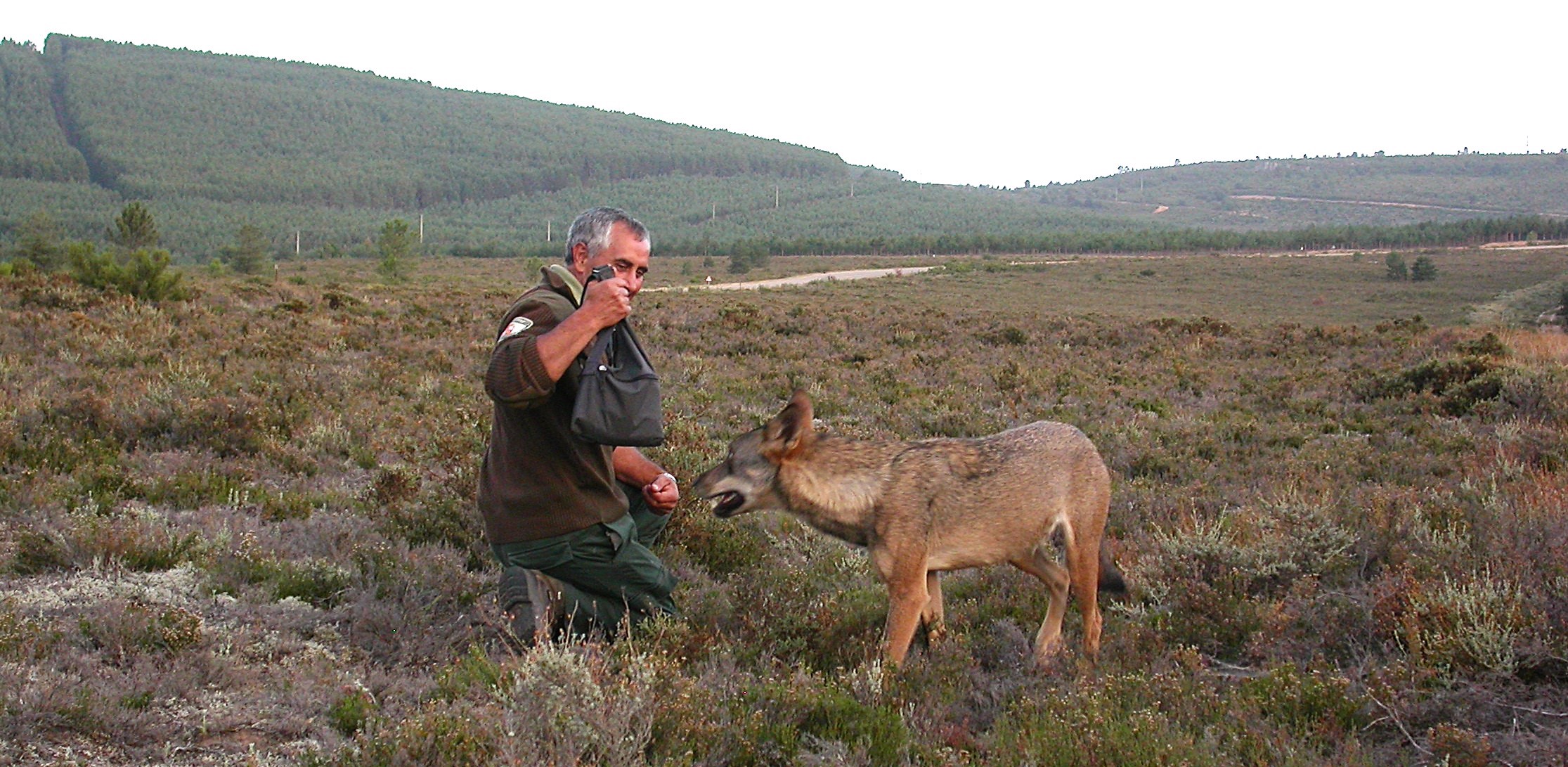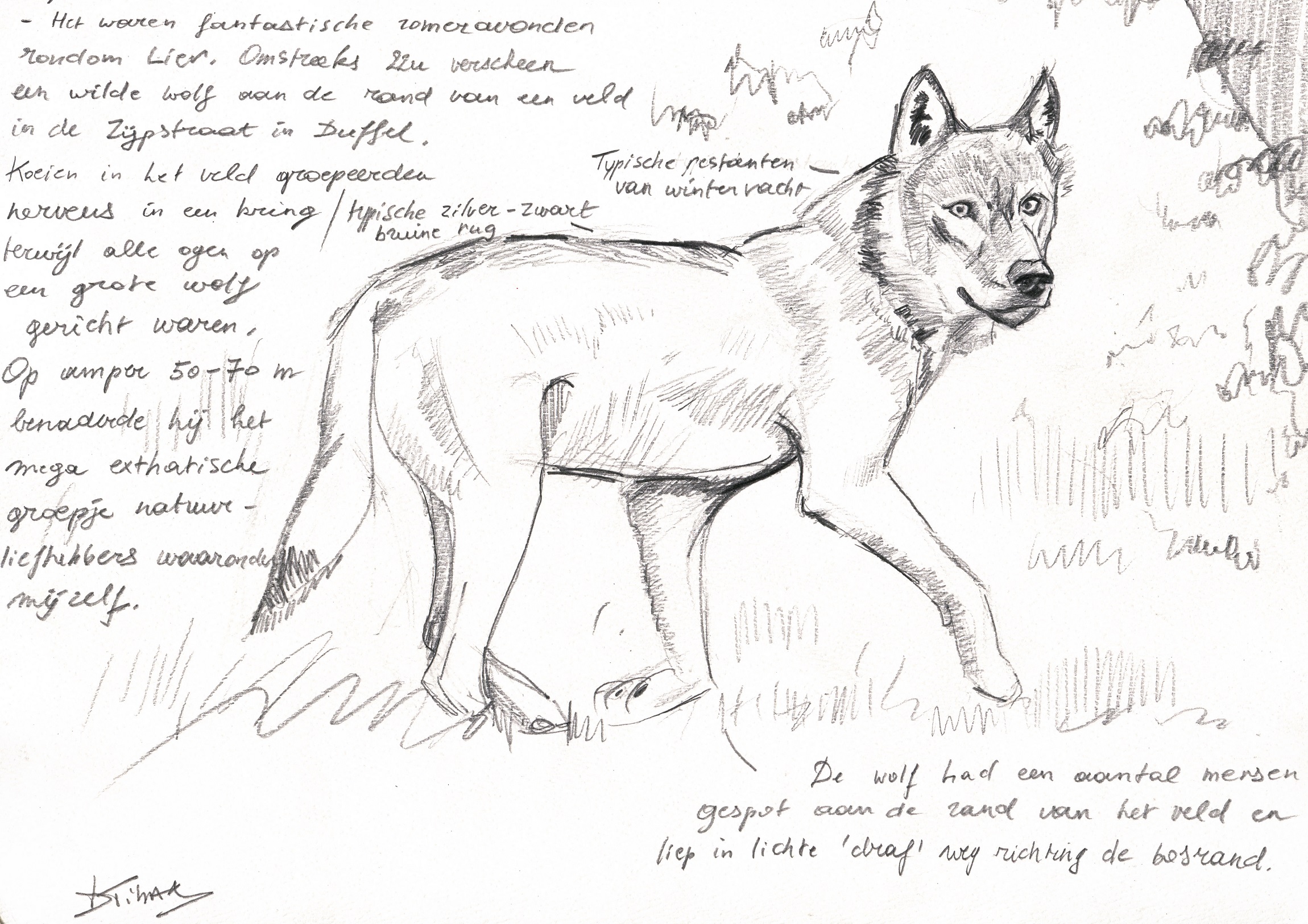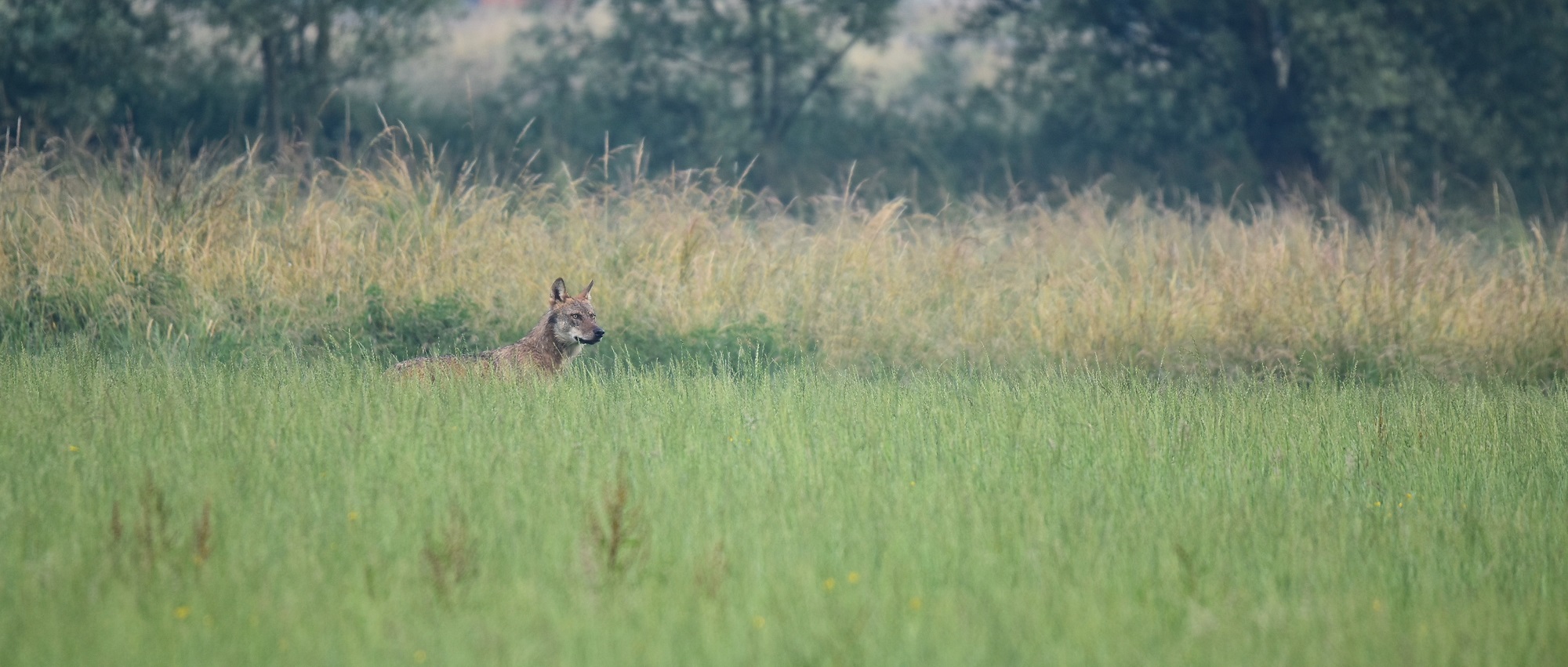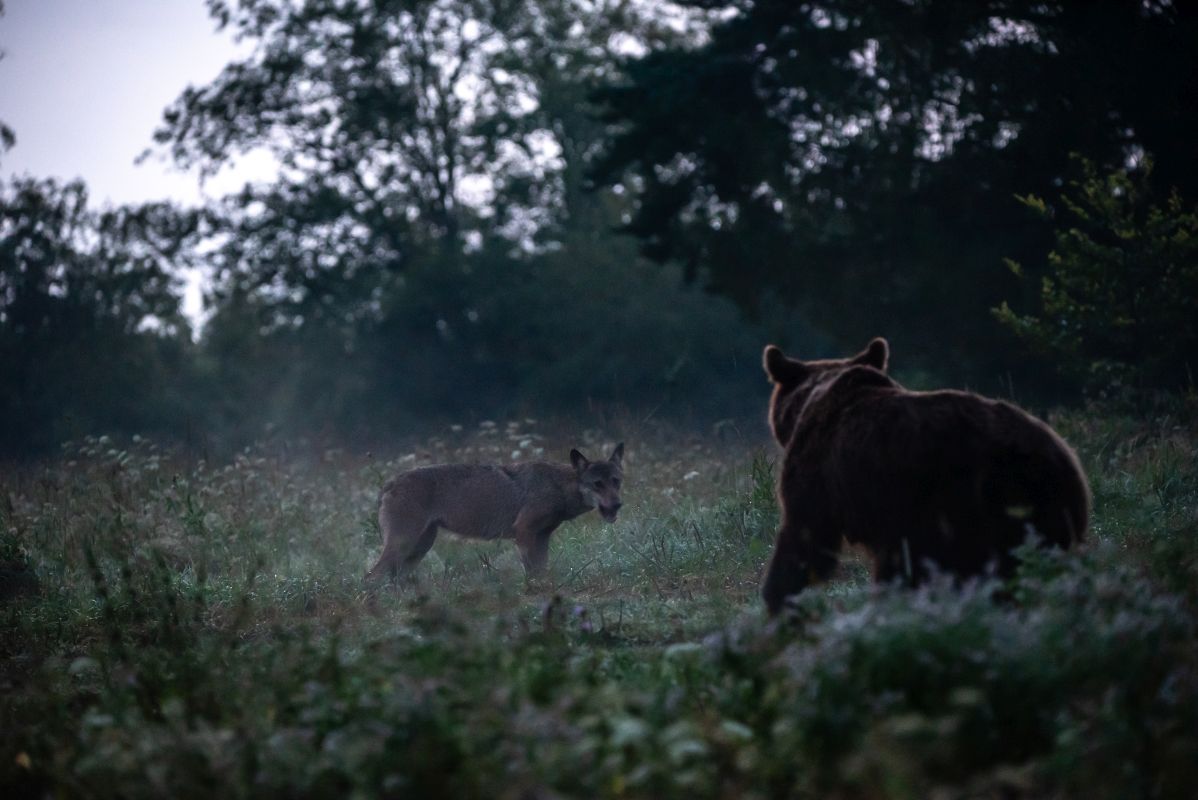2020 – YEAR OF THE WOLF
Introduction
Sunday noon, the 7th of June 2020. My wife scrolling down over some news sites, suddenly yells out ‘Aha, a wolf in the town of Duffel’. It wasn’t about the news overkill relating to facts and figures of the pandemic, my ears are suddenly working. The specific stake out, an urban pasture with horses, where the wolf has been spotted and filmed by locals with their mobile phones, surprisingly looks familiar to me as I was born and raised in the village of Duffel. Back in those days, meeting outdoor with bikes still was a common sight while being a teenager. Traffic was less numerous and open areas to hang around and explore with teenage fellows were still plentiful. It acted as a social network equal with the way teenagers nowadays chat all day long with each other. I must confess now and then I have a rather melancholic feeling when I see my daughter belongs to this new social media generation that takes place indoors. Luckily she still likes to be outside too and her weekly Sunday afternoon scout activities are something not to miss! As she accompanies myself during prospections, quite sure too that few kids of her age have had numerous close encounters with bears, wolves and lynx! Such an occasion happened in Norhtern Spain while watching a pack of appearing Iberian Wolves.
Personal wildlife experiences relating to large carnivores in Europe
Being 44 myself in 2020, I had left Duffel for about a decade as real estate was way too expensive in my home town. Instead we (myself, wife and daughter) moved to Mechelen. A nearby city where we were able to buy a house. Also, once graduated as a teacher, my real interest was being into nature as much as possible. I wasn’t interested in materialism, neither busy at all in getting settled. Instead, I followed in the footsteps of my father, I became a devoted birdwatcher from an age of 16. I built up my knowledge from the garden feeders, became a member of a resident bird migration post and took part in field trips of a local birding organisation. Hungry like an autumn bear, I continued expanding my knowledge by twitching and travelling outside Belgian boundaries. In the nineties still within Western Palearctic boundaries – from the millennium onwards worldwide. Nowadays I mostly share my personal knowledge while acting as a naturalist guide on wildlife tours.
Mammalwise
- Full frame Eurasian Wolves in front of camera after marathon session in hide, Oktober 2020 – Bieszczady Poland © H. Netthoefel
Wonder and interest for mammals has always been a part of my passion. Though, back in those days, sources of knowledge were way less compared to the vast opportunities mammal wise currently available. I still remember eagerly exploring the Swedish woods near the town of Gävle where I took part in an ERSAMUS exchange program in 1997. While looking for owls, woodpeckers and grouse, it was the footprints of Eurasian Lynx that inspired me all the time! They once led me to a freshly made kill of this felid – a Roe Deer hidden away beneath a pile of dirt and fallen branches. However, the real life changer for sure was my first ever eyeball to eyeball encounter with a large carnivore while travelling back from a birding trip (July 1999) all the way to the Varanger fjord, Northern Norway. Before reaching home, myself and a fellow had a last real stop over in Southern Sweden. More precisely, the encounter happened again in the same woods of Gävle in Central Sweden. This time we were heading towards a local spot for Nightjars with Per Aspeberg, a resident fellow birder-ringer I met during my ERASMUS exchange program 2 years earlier. Suddenly Per brought the car to a sudden and swift stop, the reason was the appearance of a Eurasian Lynx Lynx lynx popping up out of the blue on the dirt road just in front of us. In a split second total joy and full frame happiness resulting in a shaking 20 year old Toyota Corolla filled with people expressing their unexpected big hit with yells, balled fists, embraces and high fives!
The memory lane image of that pale, crouched Northern Lynx (one of the six subspecies of Eurasian Lynx worldwide), still is a copy and paste of the The Atlas of European Mammals front cover. In my early days, that book (Mitchell & Jones ea, published by T & A D Poyser) was the standard reference of European mammals. Always when I take that book from my personal wildlife library, I have a flash back to that 18th of July 1999 once in a lifetime wildlife moment! Gives value to life!
- Pano of Sierra de la Culebra ; the cradle of European Wolf watching © Jan Kelchtermans
Wolf wise I’ve been into the wildlife scene for many years now. Several trips have taken me to remote corners of Spain, Poland and Finland on a yearly basis. More precisely in areas where these epic predators still are numerous, thrive and roam freely. Over the years I feel privileged to have had plentiful, prolonged and a wide variety of wolf observations. Besides numerous sightings of Eurasian Wolf (the nominate race Canis lupus lupus) in Finland and Poland, I am also quite familiar with Iberian Wolves (aka the subspecies Canis lupus signatus) in the border area of Spain and Portugal (Sierra de la Culebra) and near Picos de Europa (Cantabrian Mountains).
- Lolli. A former alpha female Iberian Wolf at Ferreras – Sierra de la Culebra, June 2007 © EB5 network
Worldwide I’ve seen four more subspecies: Arabian Wolf, Indian Wolf, Tibetan Wolf and North African Golden Wolf.
A lone Arabian Wolf Canis lupus arabs was seen by coincidence as suddenly one came into view while scanning the Negev desert in search for MacQueen’s Bustards at Nizana during the 2018-2019 year change, Israel.
The threatened Indian Wolf Canus lupus indica I have seen during three occasions: twice in the Blackbuck NP near Velavadar and, rather remarkably, also once near Rann Riders: a lovely resort in the Little Rann of Kutch famous for its Indian Wild Ass. Both places are located in the Gujarat province, India.
- Tibetan Plateau © Jan Kelchtermans
Being into guiding and prospection trips for Snow Leopards, I also have had several encounters with Tibetan Wolves Canus lupus chanco. A great encounter with several pack members near a Kiang carcass (aka Tibetan Wild Ass) at lake Tsokar, in the Ladakh province of India. Several more encounters with Tibetan Wolves took place on the Tibetan Plateau of the Qinghai province in China. A detailed report of these observations can be found in a different NEWS item on the EB5 website.
- An old, lone Tibetan Wolf © Jan Kelchtermans
The subspecies occuring in Morocco/Western Sahara, aka North African Golden Wolf Canis lupaster lupaster, I’ve seen while on a quest for Sand Cat. They don’t look like wolves, they look more like Golden Jackals which is what they were originally believed to be. It took a lot of research/genetics to positively prove that in fact they are a species of wolf.
- Habitat of North African Golden Wolf Canis lupaster lupaster, Marocco/Western Sahara – January 2020 © Jan Kelchtermans
A wild wolf experience in my home town in times of lock down!
Given the fact of being abroad all the time while into real wildlife, I must confess that it’s now only occasionally that I still explore my home range in recent years. But, being in lock down since the 18th of March, life all of sudden became totally different. During the first real lock down (18th of March till the 18th of May 2020) travelling seems so far away and, even with a car, things are very limited. Anyway anyhow, the situation is out of our control. Nothing we can do about it.
So, while cycling (the same tour for weeks) during the afternoon of that lovely, sunny 6th of June, my mind keeps on spinning about the wolf sighting in my nearby home town. I struggle with feelings of disbelief, excitement and confusion. Although I feel rather stupid myself, in the end I just decide to give it a try. Why ever not? Nothing to loose and for sure something else different from the daily routine for weeks (caused by lock down restrictions) now. So, accompanied by my daughter, I drive off my personal lane after dinner in the evening of 6th of June 2020. Within 20 minutes, with tripod, scope, binos and camera gear stored on the back seat, we arrive at the spot where the wolf had been seen the previous day: an urban area with a patchwork of houses, front gardens, pastures and agricultural fields fenced with barbed wire. After a decade of posting myself on vantage points from where scanning vast and desolate areas for the presence of wolves, I can only say to myself: what the hell I am doing here? As everything looks so wrong and unfamiliar, I can’t change my mind into a focused wolf modus. I just feel horrible! At 6pm, some different people arrive in the area with the same purpose: trying to succeed in a wild wolf experience! When one of them seriously says ‘it’s now or never’ I must confess I laughed at him. Silently I whisper to myself ‘the most stupid, unexperienced wolf quote I’ve heard in a long time’.
- EB5 founder Jan near footprints of an Eurasian Wolf, 7th of June 2020 © Louise Kelchtermans
- Footprints of an Eurasian Wolf, 7th of June 2020 © Louise Kelchtermans
Nevertheless: we park the car and approach some believers busy checking a ploughed field littered with young lettuce. A track of obvious wolf prints, running straight through the field leads to a nearby pasture where the wolf killed several sheep the night before. The prints look very fresh and, caused by the muddy soil, rather big! Always impressive such signs of a large predator! They actually are a first sparkle of belief that there might indeed be a wolf around. When curious locals inform us they have seen the wolf until 9am that morning, my belief starts to grow. Especially when they mention the wolf was just loitering around on paved roads cutting through the urban area! One of the believers forges a plan to split up in subgroups and post nearby on different open areas offering a wider view and a bit of cover. Definitely a good strategy to increase our chances in locating a wolf potentially hiding nearby, at dusk, might become active again and find its way to the field where it killed some sheep the night before. What I thought never would happen does happen: a bit after 10pm suddenly these two words appear in the whatsapp group made for this gathering: NOW HERE! I must confess, even after a decade of numerous wolf observations, adrenaline suddenly disturbs all normal behavior. Totally irresponsible driving brings me in a couple of minutes back at the lettuce field and surrounding area. The wolf, popping up in an opposite cattle field, went for cover in a nearby small forest patch. The evidence image of the wolf shown on a camera display hits deep. Ace!
- The Duffel Wolf, 7th of June 2020 © Jan Rottiers
After some very nervous minutes, I suddenly notice the cattle behave similar to fixed Red Deer (witnessed in Poland and Spain regularly) all looking in one direction. As the corner of the field bordering the forest patch isn’t visible from my view point I walk a bit onto a lane of a residential house. Now I see what the cows are aware of: the WOLF! Euphoria takes over! The only one not being confused with this situation seems to be the wolf himself. Where unadulterated adrenaline, pure joy and insanity dominates over the local scene, the wolf stands its ground. He obviously is familiar with this kind of situation. In a fixed posture he looks to what definitely is an excellent buffet! But the cows don’t trust the bizarre situation. Avoiding what would have been definitely a wolf hunt, they turn and dash off! Instead of slowing down and withdraw into safety of the nearby forest patch, the wolf himself starts to move in our direction. Totally relaxed he sniffs around, urinates and scratch his ears. Once at a distance of approx. 80 metres, he notices our presence. With pointed ears and lifted head he looks at us. Besides being large in size, we witness his strong trunk, sloping back, long and strong limbs. Especially the broad forehead and the powerful jaws really look impressive. Although clearly in full summer coat, some remaining tuft of winter fur result in funny looking whiskers. Nevertheless being aware of us, it continues it’s way towards the adjacent fields on the opposite site of the tarmac. Unfortunately, frightened by a passing mother with a child buggy, the wolf aborts its stroll and retreats into cover and safety of the forest patch. It is a sudden end of Belgian history: the first ever Wolf twitching scene!
- Field sketch of the Duffel Wolf, 7th of June 2020 © Detlef Tibax
After months forced to be happy with nature near our local patch caused by lock down restrictions, this level of wildlife watching was something many of us needed! Personally I never dreamed about a wolf observation in my home town! Life is full of surprises! Always expect the unexpected!
The sequel and chronicle of a dead wolf foretold
As with everything in these digital days, the news spreads like wild fire. Instead of a the manageable group of 15 people on the historic day of the 6th of June 2020, next day many more people try their luck in spotting the wolf. Which of course doesn’t work out. Besides people walking into fields and forest patches, they move their car from one place to another all the time. It results in a chased wolf running away from his shelter. I was lucky to spot the wolf near my home town a second time when he decides to leave the twitching scene: at high speed I see him running through a field frightening local horses. He continues his escape by taking a paved road that leads towards a channel. Being stuck in the vegetation between the channel and the nearby ditch, the only route he can take is the public road that runs parallel with the channel. Luckily it is a one-way road, so traffic is absent. In a few minutes the speedy wolf is a small fading dot in the far distance. Efforts of twitchers arriving at the scene are all in vain. The wolf had vanished!
- Eurasian Wolf, Duffel-Lier 8th of June 2020 © Simon Feys
Nevertheless in an uncomfortable situation for enthusiastic naturalists the wolf stays around for about 10 days afterwards. Also he keeps preying on cattle all the time. Besides more sheep he even kills an adult cow weakened by the fact she had given birth to a calf. Updates of sightings are kept more or less secret. Given my broad network I am informed about another sheltering area of the wolf. The 16th of June I saw the wolf a third time performing several attacks on a herd of horses. It feels like gazing a wildlife moshpit consisting of horses and a Wolf! Driving home afterwards I swap between different feelings and thoughts after this observation.
- The first ever twichable Eurasian Wolf for Belgium © Yente Demaesschalck
In the end one thing will be a certainty: sooner or later this wolf will look into the barrel of a gun. This actually happened in France last September as the wolf was killed because of it being stamped as a pest species preying on livestock. This wolf didn’t know any better as he copy and pasted his cattle killing instinct from his parents. Originated in Germany, the pack he was a member of did exactly the same. It shows that, as soon as wild animals rise in good numbers, conflicts are unavoidable with humans. Especially in Western Europe where humanity, and especially farmland, overrules the landscape completely.
Reclaiming former Belgian Wolf territories
Recent recolonisation of the Belgian land by wolves is very exciting! Especially in Flanders. This is just remarkable because the Flemish part of Belgium is definitely the most heavily populated area of Belgium! Besides some loners trotting around, we also have a resident pair present largely within the safety of the boundaries of a military zone closed to the public. It’s actually the second year in a row now they have been there but last year the pregnant alfa female was very sadly and illegally shot by hunters. Despite the best effort of man to exterminate these wonderful creatures, like everywhere in Europe, you just can’t stop the return of these smart and brave beasts! With the appearance of a new female in December 2019, the local male has company again! It resulted in a first litter this spring 2020. Unfortunately two of them were found as road kills this autumn. It clearly shows that the idyllic scenario of roaming wolf packs hunting big game in vast and desolate areas like elsewhere in Europe, is just a wishful dream. Also in the Belgian Ardennes a couple have established another territory very recently. So yes, we have something to look forward to in Belgium!
- The first ever twichable Eurasian Wolf for Belgium © Yente Demaesschalck
Wolves in The Netherlands too
Since 2015, several wolves have wandered into The Netherlands from Germany. Most of these wolves were sub-adult individuals doing prospection for personal territories. None of them stayed for longer than a month or so. This until a female wolf from Babben (an area near Brandenburg) appeared. Her appearance was noticed in spring 2018 after wandering for more than 650 K’s. She decided to stay in the northern parts of the Veluwe, near the Dutch NP on the border with Germany. This first resident wolf in The Netherlands was joined by a male within 6 months. As the same with the female, the male’s origin is Germany. More precisely from the area near Celle, Niedersaksen. Things looked promising as both wolves kept resident in the area in spring. Currently they are considered to be the first pair to recolonise the Netherlands in a hundred and fifty years! Based on trailcam footage, they were often seen while marking their territory together. Their first litter (spring 2019) consisted of five pups. One male pup died after being hit by a car next winter. This pack got a second litter (spring 2020) with four pups. According a field observation this month (December 2020) of 7 diffrent pack members, it shows that, besides all 4 pups of the 2020 litter, at least one remaining subadult of the 2019 litter still remains with the natal pack. The pack feeds almost exclusively on wild prey species. Apart from taking some sheep at unprotected farms in autumn, they don’t cause a lot of human wildlife conflicts.
An exciting discovery is that one of the females of the 2019 litter has settled herself in the Southern parts of the Veluwe NP this summer. More over and very promising, as with the female Wolf in the Belgian Ardennes, is that she has been accompanied by a male since this December. A big chance they will become the second Dutch pack successfully breeding in the near future!
Another female settled down in the central parts of the Veluwe during the summer of 2018. She is still present in her territory though she remains alone so far. Wandering males have been very close to her and they possibly even met but she hasn’t mated yet.
- Eurasian Wolf, a pup of the Veluwe litter of 2020 © Lennart Verheuvel
Besides these Veluwe individuals, there is one other male wolf that has settled in the Netherlands since March 2020. He is quite special genetically as his roots are situated in the French Alps. This wolf currently resides in an area just South of Eindhoven where he regularly crosses the border with Belgium. Lone male wolves are known to be much more unpredictable than females in relation to permanent settlement in a territory. So, as long as he stays alone it is difficult to predict whether he will stay or continue his search for a mate elsewhere. Such another loner settled himself for nearly a year near Hooghalen in the northern part of the Netherlands. Though, recently he abandoned the area and travelled back towards Germany. His departure presumably because the ongoing absence of a female in his temporarily territory. This wolf took some sheep what actually wasn’t a surprise as the province of Drenthe (where in Hooghalen is situated) has a ridiculous policy in place that basically decides that Red Deer and Wild Boar are not allowed to live anywhere within the province. Regarded as pests to agriculture, there aren’t any large ungulates left for wolves to prey on. So, as the only wild prey available for wolves are roe deer and hares, you can hardly blame any wolf for taking livestock in this case…
Tempered enthusiasm
Despite the fact untouched wilderness is completely gone in most parts of Europe, the Western European vast mosaic of agriculture fields and production forests in general actually sustains higher ungulate densities compared to those present in old growth forests. So, for apex predators like Wolves, there is actually more prey than ever. Given their protected European status for several decades now, plus being extremely adaptable to exist in landscapes largely ruled by humans, Wolves are rapidly reclaiming their former territories from which we exterminated them in the past. Topped with a more precise understanding of ecology, ecosystems and a growing green conscience in the public, it is great to notice wolves are actually now thriving! But we must not be naïve. Sadly, wolves are still killed legally and illegally so tracking wolves stays a real challenge as these social animals are shy, elusive and extremely smart. As they have to be! In a modern world where people still have selfish opinions, just like to hunt things, and suffer from an irrational fear based on beliefs and myths these amazing creatures are faced with great challenges to succeed, but there is no doubt that they can!
- Eurasian Wolf and Eurasian Brown Bear from hide, Bieszczady – Poland © A. Ruit
Peace and harmony
Equal with observing Spain’s three large carnivores last summer, I witnessed once again superb and prolonged natural behavior of a large carnivore last autumn in Poland. I felt a relief and was grateful to observe wolf pack members showing their social and playful behavior in a landscape far away from human settlements without the the polarised debate of their come back in Western Europe. More over, it’s strengthening my persuasion that one day I’ll retreat to such a biodiverse remote corner of Europe!
Europe’s Big 5 would like to thank the following chaps for their contribution to this NEWS item:
John Wright, Mark Kaptein, Yente Demaesschalck, Lennart Verheuvel, Detlef Tibax, Johan Plouvier, Jan Rottiers, Simon Feys, Anthony Ruit.















